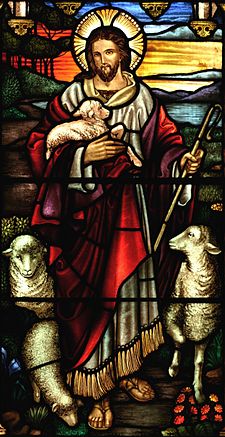Jesucristo
(Ginredirect tikang ha Jesus)
Hi Hesus (puyde liwat igsurat nga Jesus), kilala liwat nga Hesu Kristo (Jesucristo) amo an sentro han panuo nga Kristiyanismo. Importante liwat Hiya ha iba nga rehiyon. Kadam-an han simbahan Kristiyanismo, gintutuohan hiya nga Anak han Diyos. Usa ha mga importatnt nga propeta it pagkita ha Iya ha Relihiyon Islam.
| Jesus | |
|---|---|
 | |
| Natawo |
7–2 BC/BCE[1] Judaea, Roman Empire[2] |
| Namatay |
30–36 AD/CE[3] Judaea, Roman Empire |
| Hinungdan han pagkamatay | Krusipiksyon |
| Etnisidad | Hudeyo[4] |
| Home town | Nazaret, Galilee[5] |
Pinanbasaran
igliwat- ↑ Rahner (page 731) states that the consensus among historians is c. 4 BC/BCE. Sanders supports c. 4 BC/BCE. Vermes supports c. 6/5 BC/BCE. Finegan supports c. 3/2 BC/BCE. Sanders refers to the general consensus, Vermes a common 'early' date, Finegan defends comprehensively the date according to early Christian traditions.
- ↑ Brown (1999) p. 513
- ↑ Vermes (2004)
- ↑ Amy-Jill Levine writes that the entire category of ethnicity is itself fraught with with difficulty. Beyond recognizing that “Jesus was Jewish,” rarely does the scholarship address what being “Jewish” means. In the New Testament, written in Koine Greek, Jesus was referred to as an Ioudaios on three occasions, although he did not refer to himself as such. These three occasions are (1) by the Biblical Magi in Matthew 2 who referred to Jesus as "basileus ton ioudaion"; (2) by the Samaritan woman at the well in John 4 when Jesus was travelling out of Judea; and (3) by the Romans in all four gospels during the Passion who also used the phrase "basileus ton ioudaion" (see John Elliott in the Journal for the Study of the Historical Jesus 2007; 5; 119). According to Amy-Jill Levine, in light of the Holocaust, the Jewishness of Jesus increasingly has been highlighted.
- ↑ Theissen (1998) p. 165 "Our conclusion must be that Jesus came from Nazareth."